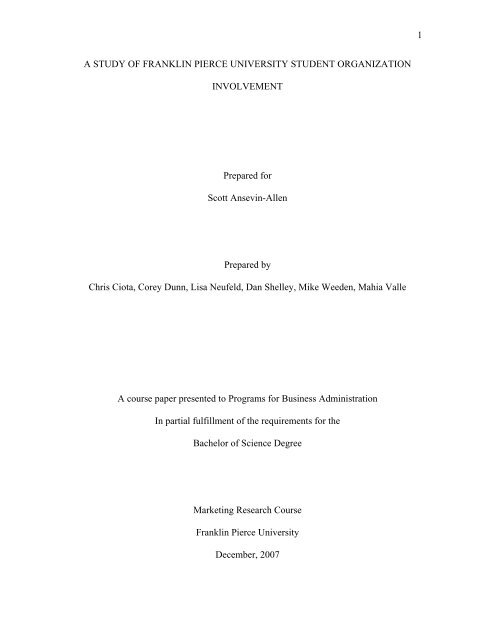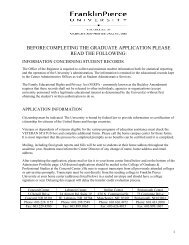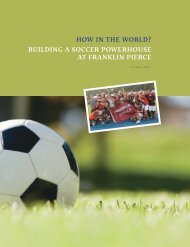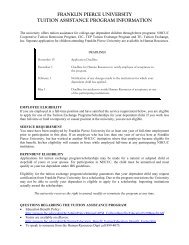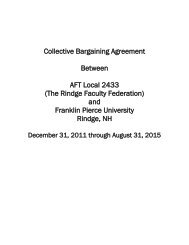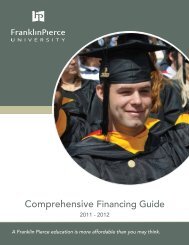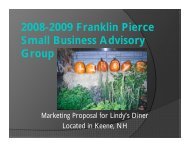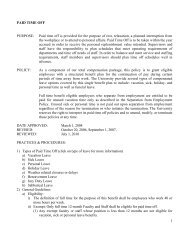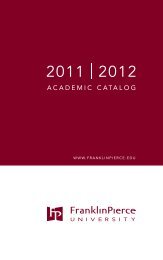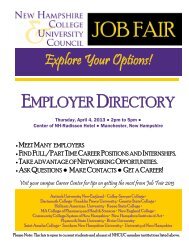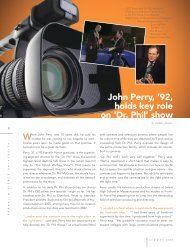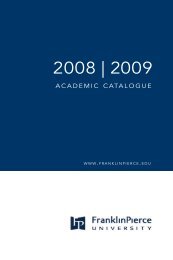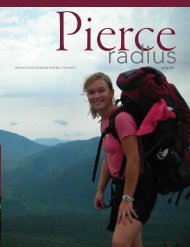Student Organization Involvement Study (PDF) - eRaven - Franklin ...
Student Organization Involvement Study (PDF) - eRaven - Franklin ...
Student Organization Involvement Study (PDF) - eRaven - Franklin ...
You also want an ePaper? Increase the reach of your titles
YUMPU automatically turns print PDFs into web optimized ePapers that Google loves.
1A STUDY OF FRANKLIN PIERCE UNIVERSITY STUDENT ORGANIZATIONINVOLVEMENTPrepared forScott Ansevin-AllenPrepared byChris Ciota, Corey Dunn, Lisa Neufeld, Dan Shelley, Mike Weeden, Mahia ValleA course paper presented to Programs for Business AdministrationIn partial fulfillment of the requirements for theBachelor of Science DegreeMarketing Research Course<strong>Franklin</strong> Pierce UniversityDecember, 2007
2Table of ContentsPageExecutive Summary.............................................................................................................4IntroductionBackground Information of <strong>Student</strong> <strong>Organization</strong>s.................................................5Nature of the Problem..............................................................................................5Purpose of the Project ..............................................................................................6Problem Statement...................................................................................................6Research Objectives.................................................................................................7Definitions................................................................................................................7Literature ReviewIntroduction..............................................................................................................8Recruitment............................................................................................................10Campus <strong>Involvement</strong> .............................................................................................11Importance of <strong>Student</strong> <strong>Involvement</strong>.......................................................................13MethodologyProblem Identification ...........................................................................................15Development of Survey .........................................................................................15Definition of Population ........................................................................................16Sample Size............................................................................................................16Data Collection Method.........................................................................................16Assumptions...........................................................................................................16Limitations .............................................................................................................17ResultsQuestion 1 ..............................................................................................................18Question 2 ..............................................................................................................18Question 3 ..............................................................................................................18Question 4 ..............................................................................................................19Question 5 ..............................................................................................................19Question 6 ..............................................................................................................19Question 7 ..............................................................................................................20Question 8 ..............................................................................................................20Question 9 ..............................................................................................................20Question 10 ............................................................................................................20Cross Tabulation 1 .................................................................................................20Cross Tabulation 2 .................................................................................................21Cross Tabulation 3 .................................................................................................21Cross Tabulation 4 .................................................................................................22Cross Tabulation 5 .................................................................................................23
3Discussion, Conclusion, RecommendationsDiscussion..............................................................................................................24Conclusion .............................................................................................................25Recommendations..................................................................................................26References..........................................................................................................................28AppendixAppendix A: FPU <strong>Student</strong> <strong>Organization</strong> <strong>Involvement</strong> Survey..............................30Appendix B: Currently an active member? ...........................................................33Appendix C: If No, what affects involvement? .....................................................34Appendix D: How many meetings attended? ........................................................35Appendix E: Rate experience with clubs...............................................................36Appendix F: How many events attended? .............................................................37Appendix G: <strong>Student</strong> involvement in Clubs/<strong>Organization</strong>s...................................38Appendix H: Male open-ended response...............................................................39Appendix I: Female open-ended response.............................................................40Appendix J: Meetings attended each month ..........................................................41Appendix K: Class standing...................................................................................42Appendix L: Gender ..............................................................................................43Appendix M: Cross Tabulation 1...........................................................................44Appendix N: Cross Tabulation 2 ...........................................................................45Appendix O: Cross Tabulation 3 ...........................................................................46Appendix P: Cross Tabulation 4............................................................................47Appendix Q: Cross Tabulation 5 ...........................................................................48
4Executive SummaryThe marketing research team conducted a study for the Department of <strong>Student</strong>Activities from <strong>Franklin</strong> Pierce University, Rindge, N.H. The purpose of this study wasto measure the level of student organization involvement at FPU. The researchersdeveloped a survey that would measure the current attendance rate of each studentorganization, to identify why students at FPU choose not to participate in studentorganizations, to determine what incentives student organizations could offer prospectivestudents, and to research other institutions in regard to the above three objectives. Theresearch demonstrated that more than half of the FPU student sample population is notcurrently active in any student organization. The research also demonstrated that most ofthe inactive students were also unfamiliar with any of the clubs offered at FPU and themain factor affecting their participation is a combination of too much course work, theiremployment, and athletic organizations. Furthermore, according to the research noninvolvedstudents were most likely to have no experience with students organizations andare less likely to attend meetings or events. The research showed the need to create moreawareness of the benefits of becoming involved in student organizations, and the need toincrease the current retention rate of student organizations as well.
5IntroductionBackground Information of <strong>Student</strong> <strong>Organization</strong>s<strong>Franklin</strong> Pierce University commits its energies and resources to creating anacademic home in the truest sense. The Institution’s curricular theme of Individual andCommunity, serves as the foundation from which the University educates studentsrepresenting a rich diversity of background. “Through the admissions process, we seekand admit students who are committed to advancing their lives, and the lives of others,through hard work, high standards, and community service” (<strong>Franklin</strong> Pierce University,2007, 1).The Department of <strong>Student</strong> Activities is dedicated to working with studentsthroughout their four years. <strong>Franklin</strong> Pierce University (FPU) encourages students toengage beyond the classroom and put into practice that which they have learned in waysnot before realized. Through <strong>Student</strong> Government, Clubs, Orientation, Alternative SpringBreak, Community Service and <strong>Student</strong> Leadership Programs they provide opportunitiesfor students to make a positive impact on the college and outside communities.Nature of the ProblemThe problem at hand is to find out why some <strong>Franklin</strong> Pierce <strong>Student</strong>schoose not to get involved in <strong>Student</strong> <strong>Involvement</strong>, consisting of clubs, and organizationson the FPU campus. FPU is located in Rindge, New Hampshire. The research team askedsome of the students on campus why they choose not to get involved, one student stated,“I don’t get involved because I never know what the clubs are, or what they offer, and Idon’t ever see them advertised” (Anonymous FPU <strong>Student</strong>, Fall 2007). The researchersthen investigated how clubs are advertised on campus. 100% of the clubs advertise in the
6Emily Flint Campus Center located at <strong>Franklin</strong> Pierce. All though the Campus Center hashigh traffic, the traffic mainly consists of underclassmen. The clubs advertise by usingthe limited amount of five 8 ½ ‘x 11’ flyers. When students are looking at five flyers ofthe 28 clubs on campus, some may get lost in the few seconds they have to read andretain the material presented on the flyer.The students also don’t see how valuable it is to them for the future, because theyare classified as Generation Y, where they take “instant gratification” over “preparing forthe future”. The researchers also asked a freshman his opinion on the matter. Sam Penny,responded by saying, “I’m only a freshmen, with four full years ahead, so there is plentyof time to get involved.”Purpose of the ProjectThe purpose of this research is to find out whether student involvement in studentorganizations can be improved. To do so the researchers will conduct surveys with thestudents on campus and obtain their results. In addition, the researchers goal is to findways to increase attendance at all current organizations. Another goal is to identify theincentives that might help students become more involved with the organizations. Theresearchers will conduct a comparison of student organizations of other universities to<strong>Franklin</strong> Pierce University.Problem StatementResearch is necessary to determine what <strong>Franklin</strong> Pierce University can do toimprove student organization involvement.
7Research ObjectivesTo measure current attendance at each student organizationTo identify why students at <strong>Franklin</strong> Pierce University choose not toparticipate in student organizations.To determine what incentives student organizations could offer prospectivestudents.Research other institutions in regard to the above three research objectives.Definitions<strong>Student</strong> <strong>Organization</strong>s: A group of students, sharing a common interest, fundedby <strong>Franklin</strong> Pierce University. This group of students must abide by their ownorganization’s constitution as well as the <strong>Student</strong> Government Association’sorganization existence policy.
8Literature ReviewIntroductionAn increasing number of students at <strong>Franklin</strong> Pierce University means thatstudent organizations must focus on increasing the current attendance rate by advertisingtheir meetings and events more heavily on campus. Current students at FPU tend to likeincentives such as, free gifts offered from organizations on campus, as well as improvingthemselves and building their resume for the future. This literature review focuses on theattendance rate of student organizations and how <strong>Franklin</strong> Pierce University can attractmore students to become involved in these organizations. With the proper knowledge, the<strong>Franklin</strong> Pierce Administration may be able to increase the attendance rate andparticipation rate of FPU students.Campus activities include a variety of academic and special interest clubs such asthe Campus Activities Board, <strong>Student</strong> Government Association, Pierce Arrow (newspaper), Raven (Year book), WFPC FM Radio Station, and twenty-five social clubs.Special events and bus trips are offered on weekends and there is a weekly movie series.Athletic programs meet the needs and interests of many students. They include manyrecreational and intramural sports. At the inter collegiate level, men compete in baseball,basketball, crew, cross country, lacrosse, golf, soccer, tennis, and ice hockey. For women,basketball, cross country, crew, golf, lacrosse, field hockey, soccer, softball, tennis, andvolleyball are available. The research team will be focusing only on student organizationsand clubs, such as the <strong>Student</strong> Government, Campus Activities Board, and every otherclub on campus.
9Understanding why college students participated in extracurricular activities suchas college student organizations can be associated with several factors. Individual studentcharacteristics, along with the present college environment (e.g., the kind of institution,the curriculum, the faculty, and peers), influenced levels of activity participation(Astin, 1993, pg. 34).The student life of an institution included "social life, opportunities to attendcultural events, opportunities to participate in extracurricular activities, and regulationsgoverning campus life" (Astin, 1993, pg 34). A student who attended a large institutionwould probably have a greater number of extracurricular activity opportunities as well ashave more diverse social opportunities, for example, like those found throughparticipation in college student organizations. <strong>Student</strong>s with more opportunities toparticipate in the overall student life of the institution could have more student-to-studentinteractions. Consequently, student interactions were found to cultivate a more activesocial life in college (Astin, 1993, pg 36). Having an active college social life byparticipating in college student organizations could influence how one perceives his orher own college experience, “Leadership experience in student organizations increasedthe development of altruistic values and social concern. Members of studentorganizations had significantly higher life management skills upon entry into collegecompared to their peers and those who pursued membership through their junior yearshowed significantly higher growth in the lifestyle skills of developing purpose andacademic autonomy. <strong>Student</strong>s who pursued leadership roles began “ahead” of their nonleadershippeers and showed continued growth, sustaining and further developing theseskills” (Mount Union College, 2007, 14).
10RecruitmentThe students need to find the unique selling point of their club, then, try to focuson the unique qualities of your organization and communicate these to the prospectivestudents. They need to remember to stay in the club’s purpose and constitution. <strong>Student</strong>sat any college campus want to know two things when it comes to potential clubs ororganizations, “What’s in it for me?” and “What do I need to do?” So the members ofclubs need to give interested students some direction by explaining the responsibilitiesand requirements expected to them by writing a job description. “They may want toinclude some of the following in the club’s job description: specific duties, qualifications,training, commitment and evaluation. Remember not to overwhelm the student with thejob description but inform them of what is expected.” (Plymouth State University, 2007, 2).Also, student organizations must learn to work along with faculty members todemonstrate the benefits of becoming a part of a student organization are to prospectivestudents. “Several researchers have described benefits of participation in studentorganizations such as more intimate interpersonal relationships, greater interdependence,and higher development in educational, career, and lifestyle plans than their peers,furthering attainment of educational and developmental goals, promoting persistence tograduation” (Powell, 2007, 3).The market research team plans to implement the following in order to effectivelymarket the student organizations on the FPU campus by advertising through: Banners,Posters, Flyers, Table Tent, Balloons, Handbill, Newspaper Ads, Brochures, StakePosters in the Ground, Press Release, Radio Stations, T-shirts, Display Cases, Posters in
11Local Businesses, Mailers, Word of Mouth, Flyers/Posters to Campus, Departments,Club Mailboxes, Graduate Offices, Library, Bulletin Boards, Music Stores, NewspaperInserts, Activities Fair, New <strong>Student</strong> Registration, Community Clubs and <strong>Organization</strong>s(Mount Union College, 2007, 15).Campus <strong>Involvement</strong>Increased satisfaction with the college experience as a result of organizationparticipation motivates college students to become active participants in the student lifeof their institution. The extracurricular activities that comprise an institution's student lifeproduce opportunities for students to interact with one another and facilitate involvementwith the social aspects of the college as well as with the more formal academicenvironment.For each of the fourteen categories of a "quality of effort" scale measuring theamount of extracurricular activities students became involved in at their campus on theCSEQ, members of college student organizations had significantly higher mean scoresthan nonmembers (Abrahamowicz, 1988, pg. 233). Activities that were cited ranged fromthe number of library visits by students to membership and participation in clubs andorganizations. One possible explanation for this result could be that college studentorganization members naturally were more involved in student life in comparison tononmembers.Extracurricular participation, however, appeared to nurture activity beyond thescope of the member's student organization. Members of college student organizationsextended their involvement into other campus areas. Increased participation in faculty
12relations, library visitation, interest in theater and the arts, and technology were a few ofthe areas cited for increase student involvement (Abrahamowicz, 1998, pg. 238).Williams and Winston, Jr. (1998, pg. 52-59) found that when compared to nonmembersof student organizations, members understood their abilities and limitationsmore clearly and began to explore their interests and values. As shown in thesignificantly higher levels of task achievement in education and career plans on theSDTLI, student organization members became more aware of resources and learningopportunities available to reach these goals. Pascarella and Terenzini (1991, 13) foundthat when thinking in retrospect, college graduates perceived their extracurricularinvolvement as "having a substantial impact on the development of interpersonal andleadership skills important to general occupational success”. College student organizationparticipation enhanced interpersonal and leadership skills, allowing students to exploretheir goals and to identify steps to achieve these goals.Schuh and Laverty (1983, pg. 28) studied the long-term effects of involvementobtained from organization participation on a sample of student leaders from threeinstitutions. Leadership positions in extracurricular activities such as student governmentand campus newspapers were found to have a positive effect on increased participation incommunity and civic organizations. In general, students continue to stay aware andbecome involved in community and political activities even after their terms as collegestudent organization leaders end (Schuh & Laverty, 1983, pg 30). The study emphasizedthat college student organization membership can be associated with continuedorganizational involvement and continued interactions with a variety of peers long aftergraduation from college.
13Continued extracurricular involvement in student organizations producedinformed citizens who actively participated in addressing those issues that are of mostinterest to them. <strong>Student</strong>s viewed community involvement in a positive light and sawtheir involvement as directly affecting their leadership skills (Schuh & Laverty, 1983, pg.32). The perceived influence on leadership and other skills emphasize the potentialimpact organizational participation could have on the development of college students.Importance of <strong>Student</strong> <strong>Involvement</strong>In order to achieve better attendance in clubs and organizations the researchersmust first understand the importance of student involvement. Mike Bosley, arepresentative of the Office of <strong>Student</strong> Affairs at the University of Central Florida wasinterviewed about the importance of student involvement in general. He spoke of howimportant it is for freshman to get involved with organizations. “First of all, it helpsmake the transition from high school into college much easier. Secondly, byparticipating in events, students are able to meet new and exciting people. Finally,students are able to receive excellent opportunities for individual growth anddevelopment through university involvement” (Baker, 2007, 6).There are also advantages and disadvantages in which Mr. Bosley spoke about.The disadvantages were over-commitment and poor academic performance. However,Mr. Bosley quickly stated that the advantages “outweighed the disadvantages.” Bycarefully choosing a type of club or organization that interests them the most, it reducesover-commitment and decreases poor academic performance. There are long-termbenefits to joining a club/organization. “Pre-professional clubs are best for studentswhose desire is to receive career training before graduating and entering the work force.”
14Although Mr. Bosley states that “there are, every now and then, minimal duesstudents must pay to help off-set operating costs,” there are no clubs/organizations on the<strong>Franklin</strong> Pierce University campus that are like this. The University funds all studentorganizations.<strong>Franklin</strong> Pierce University attracts in-coming freshmen to join clubs andorganizations by formulating club/organization sponsored events and activities during thefreshmen orientation. This act can be compared to the University of Central Florida.Both UCF and FPU can compare in various aspects of student attractions and enrollmentissues by putting signs up concerning up-coming events, posting banners aboutenrollment into clubs and organizations around campus hot spots, and by giving new andtransfer students packets of information regarding various clubs and organizations oncampus.
15MethodologyProblem IdentificationThe marketing research team from <strong>Franklin</strong> Pierce University conducted researchfor the Department of <strong>Student</strong> Activities. The research is necessary to identify whystudents choose to get involved in student activities (clubs and organizations). Theresearch team then took it a step further and researched why students choose not to getinvolved in clubs and organizations on campus.Some of the students on the <strong>Franklin</strong> Pierce campus aren’t aware of all the clubsthat are available on campus. Some clubs only advertise by putting up a flyer in thecampus center, so their name doesn’t reach the whole campus. On the other hand, somestudents know that there are clubs on campus, but they just don’t know what they offer,or when they meet. Bailey Gaffney wanted to join <strong>Student</strong>s In Free Enterprise (SIFE), butshe said, “I know exactly what they do, I just don’t know when they meet”(B. Gaffney,Personal Communication, Fall 2007).Development of SurveyTo develop the survey the research team began by talking with Scott Ansevin-Allen, the director of student activities of <strong>Franklin</strong> Pierce University in Rindge, NH, todevelop research objectives. The research objectives were developed on October 2, 2007and reviewed by Scott Ansevin-Allen on October 12, 2007. The survey was then createdon October 26, 2007 and reviewed by the marketing research class at <strong>Franklin</strong> PierceUniversity on November 2, 2007. After the class reviewed the survey, the research teammade revisions and turned in the newly revised copy to Dr. Jason Little on November 7,2007. Dr. Little revised the survey and handed it back to the research team on November
169, 2007. The research team then completed final revisions to the survey on November 9,2007.Definition of PopulationThe population is the Rindge campus of <strong>Franklin</strong> Pierce University which consistsof 1,700 students. The researchers chose this as the population because the research is todetermine if students participate in student activities including clubs and organizations. Itis an accessible population that is easy to get in touch with in the short time period forconducting research.Sample SizeThe sample was 160 students at the Rindge campus, 80 males and 80 females.Also, the sample consisted of 40 people of each class standing (freshman, sophomore,junior, senior), 20 females from each class as well as 20 males.Data Collection MethodThe researchers used the non-probability convenience sampling method. Theresearchers handed out the questionnaires to students in the campus center, classroomsand dormitories. These questionnaires were handed out from November 12-20 2007. Theresearchers also used a quota sampling method based on gender and class standing to getan equal response from each class as well as both genders.AssumptionsThe researchers assumed that all of the students answered the survey correctly andhonestly. The researchers also assumed that everyone answered all of the questions andthat they were interested in the survey.
17LimitationsThe researchers found that time and the small sample size to be limitations to theresearch process. More available time would have allowed for a greater samplepopulation.
18ResultsQuestion 1An average of 52.5% of respondents answered “No” to being an active member ofa FPU student organization. Out of the 160 students surveyed 47.5% of the samplepopulation answered “yes” to being currently active members of an FPU studentorganization. This demonstrates a lack of involvement in FPU clubs, due to the fact theover half of the sample population said they are not currently involved in any clubs(Appendix B).Question 2Out of 86 responses for question 2, a total of 28 (17.5%) respondents stated that acombination of too much course work, their employment, and athletic teams, affect theirinvolvement in these student organization. 7.5% (12) of the respondents simply have toomuch course work, 6.3% (10) say their employment affects their participation, and 7.5%(12) responded that they were athletes (Appendix C).Question 3The research demonstrated that although 26.3% of students rate their overallstudent organization experience as “Good”, 15.6% of the FPU student community iscompletely “Unfamiliar” with any of the student organizations offered. A total of 7students out of 160 (4.4%) rated their experience with student organizations as “Poor”.21.3%, meaning that 34 respondents rated their club experiences as “Fair”. 27 (16.9%)students stated that their experience was “Very Good”, and a sum of 25 respondentsclaimed that their experience with the organizations was “Excellent” (Appendix D).
19Question 4When asked how many times they attended a student organization meeting in thepast month, 77 out of 160 students attend “0” meetings a month, that is 48.1% of thesample population that does not attend any meetings at all. 10% of students attend “9+”meetings a month, 9.4% attend 3 meetings a month, 7.5% attend 4 meetings a month,7.5% attend 2 meetings per month, 6.3% attend 5 meetings a month, 5.6% attend 6meetings per month, .6% attend 7 meetings, and .6% attend 8 meetings a month(Appendix E).Question 5A total of 59 respondents attend “0” organizations events a month, which is36.9% of the sample population, 33 respondents said they attend “1” event a month,20.6% of the sample population, 23 students claimed they attend “2” events a month,14.4% of the sample, 18 students said they attend “3” events a month, 11.3%, 13 studentsstated that they attend “4” events a month, 8.1% of the sample, and finally 14 studentsstated that they attend “5+” events a month, 8.8% of the sample population (Appendix F).Question 6In question 6, respondents were asked to circle the club(s)/student organization(s)that they are currently involved in. 9.4% of the sample is involved in the CampusActivities Board (CAB); second most involved club surveyed is the Gamers club with8.8%. The clubs with the least amount of student activity as shown through the surveyare Amnesty International, Gospel Choir, and Yearbook with 0.0% (Appendix G).
20Question 7<strong>Student</strong>s were given the freedom to write in a club, if it was not currently beingoffered on the Rindge campus. 23 male students and 19 female students out of the 160gladly suggested new and interesting clubs. The top male responses includesnowboarding, adult cinema, paranormal, and food. The top female responses includesnowboarding, culinary arts, and gymnastics (Appendix H, I).Question 8In question 8, students were asked to specify the approximate amount of timesthey attend student clubs/organizations each month. The results for each category are asfollows: none 48.8%, 1-2 meetings 10.6%, 3-5 meetings 23.8%, 6-8 meetings 8.0%, 9+meetings 8.8% (Appendix J).Question 9The survey involved 23.8% freshmen, 30% sophomores, 23.7% juniors, and22.5% seniors (Appendix K).Question 10Respondents indicated their gender in question number 10. 53.1% of therespondents were male, and 46.9% of the respondents were female (Appendix L).Cross Tabulation 1The cross tabulation showed that sophomores were most likely to currently activebe members of a FPU student organization, while freshmen were least likely to be activemembers of any student organizations. Out of 38 freshmen students, 28 responded “No”to being a part of a club. Out of 48 sophomores 34 responded “Yes” to being active
21members, juniors had 38 student answers, and 20 of those said “No”. Finally, out of 36seniors 22 said “No” to being active members of a club (Appendix M).Cross Tabulation 2The cross tabulation showed that a slightly more than half of the male and femalesample populations are not active members of an organization. Out of 85 malerespondents, 45 said “No” and 40 said “Yes”. Out of 75 female respondents, 39 said“No” and 36 said “Yes” (Appendix N).Cross Tabulation 3The cross tabulations demonstrate that students who are active members in astudent organization are more likely to have a better overall experience with the currentclubs and organizations offered at FPU. These students’ responses ranged from 8respondents saying they had a “Fair” overall experience, 20 stating they had a “Good”overall experience, 23 stating they had a “Very Good” overall experience, 24 stating theyhad an “Excellent” overall experience, and one respondent who said they wereunfamiliar.On the other hand, uninvolved students are most likely to either have a “Fair”overall experience, with 26 respondents claiming this out of 84 who answered “No” tobeing active member, and 24 of the 84 respondents stated that they are completely“Unfamiliar” with any of the clubs offered at FPU. Seven respondents claimed that theyhad a “Poor” overall experience, 22 more stated that they had a “Good” overallexperience, 4 said they had a “Very Good” experience, and 1 respondent said they had an“Excellent” overall experience (Appendix O).
22Cross Tabulations 4The cross tabulations shows that, the majority of students, regardless of their classstanding consider a combination of too much course work, employment, and athleticorganizations prevent them from becoming involved in student organizations. Twentyeightof the 86 students who are not active members of a club chose this response. In thecross tabulation, research demonstrates that seniors are most likely to claim that too muchcoursework prevents them from becoming involved, with 6 respondents out of the 23seniors. However, sophomores are least likely to have too much course work affect theirinvolvement, with 1 respondent out of the 15 sophomores. Freshmen and sophomoresboth with 3 respondents each said their employment was the major reason for their lackof involvement. Juniors and seniors both coincided with 2 respondents each, who alsostated that their employment affected their involvement. Subsequently, freshmen weremost likely to be athletes, with 4 responses. Both sophomores and juniors had 3respondents each and in this case seniors were least likely to be athletes with only 2responses.The research also demonstrates that juniors and seniors are most likely to have acombination of too much course work, employment, and athletic organizations whichprevent them from becoming involved in student organizations. However, sophomoreswe recorded as being the least likely to be affected by a combination of these factors,with 5 respondents claiming so. Finally, freshmen were most likely to respond “Other” tifactors that affect their involvement, with 11 votes, while sophomores were least likely tochoose “Other” with only 3 votes. Both juniors and seniors had similar results with 5respondents each, stating that “Other” factors affected their involvement (Appendix P).
23Cross Tabulation 5The cross tabulation shows that females are most likely to consider “too muchcoursework” a factor which prevents their involvement, with 6 female respondents out of39, while 6 males responded the same out of 47 respondents. 6 out of 47 malerespondents claimed that their employment affected their involvement, while 4 out of 39females claimed this to be the problem. Female respondents were more likely to beathletes, with 7 out of 39 respondents choosing this answer, while 5 out of 47 malesclaimed to be athletes. Males were most likely to choose “a combination of the above” asthe factor that affects their involvement, with 15 male responses and 13 female responses.Furthermore, male respondents were most likely to choose “Other”, with 15 votes. On theother hand, 9 female respondents chose “Other” (Appendix Q).
24Discussion, Conclusion, RecommendationDiscussionAccording to the collected survey responses from <strong>Franklin</strong> Pierce Universitystudents, 84 of the 160 students surveyed, more than half said they were not activemembers of a student organization. This is directly linked to the literature review whichstates, “Anything we can do to increase the amount of time that new college studentsspend on campus – in study groups, in the library, in co-curricular activities, andespecially in living and working on campus – will enhance their probability of success”(Gardner, 1996). There is a need to create awareness of student organizations on campus.As the survey clearly demonstrates, 15.6% of the FPU sample student populationresponded that they were completely “Unfamiliar” with any clubs or studentorganizations. Again, students that are unfamiliar with student organizations are notaware of the benefits and the current incentives being offered, such as club events andmeetings. According to the results the current incentives have not aided in increasing thestudent organization retention rate at FPU. In relation to the literature, “If you choose toget an education, know that it won’t happen just in the classroom. The balance of yourcollege education, and some of your most memorable experiences, will take place withinstudent organizations” (Mount Union College, 2007).Our research also coincides with literature stating that, “On the other hand, typesof ‘noninvolvement’ are found to be congruent with the lives of adult students. Mostadult students live off-campus, commute to school, attend part-time, and are employedoff campus, often full-time. These activities remove adult students from the universitycampus and decrease the likelihood of positive involvements and interactions with peers
25who share similar struggles and experiences”(Morgan, 2002). The previous statementrelates to the survey results from question two, which asked the non-active students tochoose what factors affect their involvement in the student organizations. These resultsdetermined that out of these 86 students, 28 respondents agreed that a combination of toomuch coursework, their employment, and athletic organizations prevent them frombecoming involved in student organizations.Question seven asked students to write in a club they’d like to see on campus. 9students wrote in that they’d be interested in having a snowboarding club on campus.This result was almost equally prominent among male and female students, with 5 malewrite ins and 4 female write ins. Although this does not directly relate to the literature, itsresult demonstrates that there are other clubs in demand. Along with the snowboardingclub, students also agreed on a paranormal club, a food club, and an adult cinema club, allwhich had at least three votes.ConclusionsAfter surveying 160 students at the <strong>Franklin</strong> Pierce University, we have come tothe conclusion that a lack of student involvement does exist at FPU. The researchdemonstrated that more than half of the sample population is not involved in a studentorganization. Next, the researchers were able to determine why FPU students do notbecome involved in student organizations. The results showed that the top reasonstudents are not becoming involved on campus is because of a combination of too muchcourse work, their employment, and athletic organizations.However, the majority of the sample population agreed that their experience withthe student organizations were generally “Good”. The sophomore class demonstrated to
26be the most actively involved class, freshmen were the least involved class. This isevidence of the existing lack of awareness and general knowledge on studentorganizations at FPU. The Department of <strong>Student</strong> Activities should focus on capturingthe students attention in a different way, it is necessary that they reengineer their previousforms of advertising.In conclusion, the research has allowed the team to measure the attendance rate ofmembers of student organizations. Currently, 52.2% of FPU students are not activemembers. The research team has also been able to identify why students are notparticipating in students organizations. The results showed that most students chose “acombination of the above”, meaning that, too much course work, their employment andathletic organizations prevent the students from become active club members. TheDepartment of <strong>Student</strong> Activities should also focus on expressing the benefits ofbecoming part of a student organization. Finally, the survey has effectively measured therate of student involvement at <strong>Franklin</strong> Pierce University, and why students are not aseager to become involved.RecommendationsBased on the compilation of survey result and literature, the market research teamfound that awareness of student organizations must improve. The Department of <strong>Student</strong>Activities should focus on advertising the benefits of becoming involved in a studentorganization. “Awareness of student preferences will help aid student leaders, members,and advisors in planning and conducting programs” (Powell 2007).According to the literature, the benefits of participating in student organizationsinclude, gaining interpersonal skills, leadership skills, networking, building student
27resumes, setting and attaining goals, among others. In order for this to function, theDepartment of <strong>Student</strong> Activities should also work closely along with faculty members tofurther motivate students to become a part of these organizations. <strong>Student</strong> organizationsmust also make sure they are efficiently advertising their clubs, meetings and events tothe appropriate target audience. The market research team recommends using banners,flyers, in-mail ads, radio ads, television ads, and newspaper ads. The researchers alsorecommend avoiding mass, cluttered, or bulk advertisements, so to not lose a potentialstudents’ attention. Faculty, students, and the Department of <strong>Student</strong> Activities must allwork together to effectively promote student organization awareness at <strong>Franklin</strong> PierceUniversity, and should aim to increase the student involvement rate by focusing onshowing students what they can get out of being a part of a FPU student organization.
28ReferencesAbrahamowicz, D. (1988). College involvement, perceptions, and satisfaction: A studyof membership in student organizations. Journal of College <strong>Student</strong> Development,29(3), 233-238.Astin, A.W. (1993). What matters in college? Four-critical years revisited. SanFrancisco: Jossey-Bass.Baker, A (2007). Plymouth.edu. Retrieved October 16,2007 from http://plymouth.edu.(M. Chamberlin, personal communication, March 5,1998).Morgan, W. (2002). A Journey Through Adult <strong>Student</strong> <strong>Involvement</strong> on Campus.Retrieved October 17, 2007 from:http://www.colostate.edu/depts/SAHE/JOURNAL2/2001/Journey.htmMount Union College (2007). <strong>Student</strong> <strong>Involvement</strong> and Leadership. Retrieved October17, 2007 from:http://www.mcu.edu/student_life/student_involvement_and_leadershipPowell, D. (2007). <strong>Student</strong> Leader Preferences: What <strong>Student</strong>s Want from <strong>Involvement</strong> in<strong>Student</strong> <strong>Organization</strong>s”. NACTA Journal. Retrieved December 6, 2007 from:http://findarticles.com/p/articles/mi_qa4062/is_200706/ai_n19434747Schuh, J.H. & Laverty, M. (1983). The perceived long-term influence of holding asignificant student leadership position. Journal of College <strong>Student</strong> Personnel,24(1), 28-32.Van Campen, J (2007). <strong>Franklin</strong> Pierce.edu. Retrieved October 16, 2007 fromhttp://fpc.edu/.Williams, M. and Winston, Jr., R.B. (1985). Participation in organized student
29activities and work: Differences in developmental task achievement of traditionalaged college students. NASPA Journal, 22(3), 52-59.
30Appendix A<strong>Franklin</strong> Pierce University <strong>Student</strong> <strong>Organization</strong> <strong>Involvement</strong> SurveyWe are a marketing research team from <strong>Franklin</strong> Pierce University, conducting researchfor the Department of <strong>Student</strong> Activities. The purpose of this survey is to determine howto improve <strong>Franklin</strong> Pierce University students’ involvement in student organizations.Your individual responses will be kept confidential and reported as aggregate data only.1. Are you currently an active member of a <strong>Franklin</strong> Pierce University <strong>Student</strong><strong>Organization</strong>?___Yes (1)___No (2)2. If you answered “No” for question #1, please indicate which of the followingfactors currently affect your involvement in student organizations.__ I have too much course work. (1)__ My employment. (2)__ I am an athlete. (3)__ A combination of the above. (4)__ Other. (5)3. Please rate your overall experiences with the current clubs and organizationsoffered at <strong>Franklin</strong> Pierce University. (Choose One)___Poor (1)___Fair (2)___Good (3)___Very good (4)___Excellent (5)___Unfamiliar with any clubs (6)4. Approximately how many times in the past month have you attended a studentorganization meeting?0 1 2 3 4 5 6 7 8 9 +
315. Approximately how many student organization events do you attend a month?0 1 2 3 4 5+6. Please indicate any club or student organization you are currently involved in: (Circleall that apply).AGAPE (1)Amnesty International (2)Anime (3)Anthropology (4)Brothers Reaching Out (5)Black <strong>Student</strong> Alliance (6)Campus Activity Board (7)Cinema (8)College Democrats (9)Psychology (20)Raven Thunder (21)<strong>Student</strong>s In Free Enterprise (22)Sci-Fi (23)<strong>Student</strong> Government Association (24)Sistuhs (25)<strong>Student</strong>s for Sensible Drug Policy (26)Wind Ensemble (27)Yearbook (28)College Republicans (10)Gamers (11)Gospel Choir (12)Graphic Design (13)Gay Straight Alliance (14)Hillel (15)Horse Power (16)International (17)Law (18)Medical (19)
327. If there is a club that is not offered at <strong>Franklin</strong> Pierce University, but interests youplease specify: ____________________________.8. Please check off the number of meetings you normally attend each month.(Check One).__ None (1)__ 1-2 meetings (2)__ 3-5 meetings (3)__ 6-8 meetings (4)__ 9+ meetings (5)9. Please indicate your class standingFreshman ___ (1) Sophomore___ (2) Junior___ (3) Senior ___ (4)10. Please indicate your gender.Male ___ (1) Female ___ (2)Thank you for your time and consideration. Your documented responses will bekept confidential and reported as aggregate data only.
33Appendix BAre you currently an active member of a <strong>Franklin</strong> Pierce University student organization?N Valid 160Missing 0Mode 2Are you currently an active member of a <strong>Franklin</strong> Pierce University student organization?ValidCumulativeFrequency Percent Valid Percent PercentYes 76 47.5 47.5 47.5No 84 52.5 52.5 100.0Total 160 100.0 100.0Are you currently an active member of a <strong>Franklin</strong> Pierce University studentorganization?605040Percent3020100YesNoAre you currently an active member of a <strong>Franklin</strong> Pierce University studentorganization?
34Appendix CIf you answered "No" for question #1, please indicate which of the following factors currently affect yourinvolvement in student organizationsN Valid 86Missing 74Mode 4If you answered "No" for question #1, please indicate which of the following factors currently affectyour involvement in student organizationsValidCumulativeFrequency Percent Valid Percent PercentI have too muchcourse work 12 7.5 14.0 14.0My employment 10 6.3 11.6 25.6I am an athlete 12 7.5 14.0 39.5A combination ofthe above 28 17.5 32.6 72.1Other 24 15.0 27.9 100.0Total 86 53.8 100.0Missing System 74 46.3Total 160 100.0If you answered "No" for question #1, please indicate which of the followingfactors currently affect your involvement in student organizations4030Percent20100I have too muchcourse workMy employmentI am an athleteA combination of theaboveOtherIf you answered "No" for question #1, please indicate which of the followingfactors currently affect your involvement in student organizations
35Appendix DApproximately how many times in the past month have you attended a student organization meeting?N Valid 160Missing 0Mode 0Approximately how many times in the past month have you attended a student organizationmeeting?ValidCumulativeFrequency Percent Valid Percent Percent0 77 48.1 48.1 48.11 7 4.4 4.4 52.52 12 7.5 7.5 60.03 15 9.4 9.4 69.44 12 7.5 7.5 76.95 10 6.3 6.3 83.16 9 5.6 5.6 88.87 1 .6 .6 89.48 1 .6 .6 90.09+ 16 10.0 10.0 100.0Total 160 100.0 100.0Approximately how many times in the past month have you attended astudent organization meeting?0123456789+
36Appendix EPlease rate your overall experiences with the current clubs and organizations offered at <strong>Franklin</strong> PierceUniversity. (Choose One).N Valid 160Missing 0Mode 3Please rate your overall experiences with the current clubs and organizations offered at <strong>Franklin</strong>Pierce University. (Choose One).ValidFrequency Percent Valid PercentCumulativePercentPoor 7 4.4 4.4 4.4Fair 34 21.3 21.3 25.6Good 42 26.3 26.3 51.9Very Good 27 16.9 16.9 68.8Excellent 25 15.6 15.6 84.4Unfamiliar with any clubs 25 15.6 15.6 100.0Total 160 100.0 100.0Please rate your overall experiences with the current clubs and organizationsoffered at <strong>Franklin</strong> Pierce University. (Choose One).PoorFairGoodVery GoodExcellentUnfamiliar with any clubs
37Appendix FApproximately how many student organization events do you attend a month?N Valid 160Missing 0Mean 1.59Mode 0Range 5Approximately how many student organization events do you attend a month?ValidCumulativeFrequency Percent Valid Percent Percent0 59 36.9 36.9 36.91 33 20.6 20.6 57.52 23 14.4 14.4 71.93 18 11.3 11.3 83.14 13 8.1 8.1 91.35+ 14 8.8 8.8 100.0Total 160 100.0 100.0Approximately how many student organization events do you attend amonth?012345+
38Appendix GPercentage of Respondents Involved in Clubs/<strong>Organization</strong>s2%2% 0%0%4%4%4%3%2%10%2%12%9%1%4%5%2%2%3%11%2% 3%2% 3%0%2% 2%2%
39Appendix H<strong>Franklin</strong> Pierce University Male <strong>Student</strong>s ResponseClubClass StandingFreshmen Sophomore Junior SeniorTotal PerClubFood 2 2AdultCinema 1 1 2 4Tv Station 1 1Paranormal 1 1 2Sports 1 1Woodwork 1 1Snowboard 3 2 5Japanese 1 1Rugby 1 1White<strong>Student</strong>Alliance 1 1Accounting 1 1Sports 1 1Specific LawPrograms 1 1Theatre 1 1Responsesper Class 6 0 7 10 23
40Appendix I<strong>Franklin</strong> Pierce University Female <strong>Student</strong>s ResponseClubClass StandingFreshmen Sophomore Junior SeniorTotal PerClubSki 1 1Food 2 2Snowboard 1 1 2 4Art 0Advocacy 1 1InvisibleChildren 1 1Knitting 1 1Literary 1 1CulinaryArts 2 2Travel Club 1 1History Club 1 1Gymnastics 1 1 2Tv Station 1 1Ski 1 1Responsesper Class 4 3 7 519
41Appendix JPlease check off the number of meetings you normally attend each month. (Check One).N Valid 160Missing 0Mode 1Please check off the number of meetings you normally attend each month. (Check One).ValidCumulativeFrequency Percent Valid Percent PercentNone 78 48.8 48.8 48.81-2 meetings 17 10.6 10.6 59.43-5 meetings 38 23.8 23.8 83.16-8 meetings 13 8.1 8.1 91.39+ meetings 14 8.8 8.8 100.0Total 160 100.0 100.0Please check off the number of meetings you normally attend each month.(Check One).5040Percent3020100None1-2 meetings3-5 meetings6-8 meetings9+ meetingsPlease check off the number of meetings you normally attend each month.(Check One).’
42Appendix KStatisticsPlease indicate your class standingN Valid 160Missing 0Mean 2.45Mode 2Please indicate your class standingValidCumulativeFrequency Percent Valid Percent PercentFreshman 38 23.8 23.8 23.8Sophomore 48 30.0 30.0 53.8Junior 38 23.8 23.8 77.5Senior 36 22.5 22.5 100.0Total 160 100.0 100.0Histogram5040Frequency3020100012345Mean = 2.45Std. Dev. = 1.086N = 160Please indicate your class standing
43Appendix LStatisticsPlease indicate your genderN Valid 160Missing 0Mode 1Please indicate your genderValidCumulativeFrequency Percent Valid Percent PercentMale 85 53.1 53.1 53.1Female 75 46.9 46.9 100.0Total 160 100.0 100.0Please indicate your genderMaleFemale
44Appendix MCountAre you currently an activemember of a <strong>Franklin</strong>Pierce University studentorganization?YesNoCross Tabulation 1Please indicate your class standingTotalFreshman Sophomore Junior Senior Freshman10 34 18 14 7628 14 20 22 84Total 38 48 38 36 160Bar Chart4030Please indicate yourclass standingFreshmanSophomoreJuniorSeniorCount20100YesNoAre you currently an active member of a <strong>Franklin</strong> PierceUniversity student organization?
45Appendix NCross Tabulation 2CountPlease indicate yourgenderTotalAre you currently an activemember of a <strong>Franklin</strong>Pierce University studentorganization?YesNoMale Female Male40 36 7645 39 84Total 85 75 160Bar Chart50Please indicate yourgenderMaleFemale40Count3020100YesNoAre you currently an active member of a <strong>Franklin</strong> PierceUniversity student organization?
46Appendix OCountAre you currently an activemember of a <strong>Franklin</strong>Pierce University studentorganization?YesNoCross Tabulation 3Please rate your overall experiences with the current clubs and organizationsoffered at <strong>Franklin</strong> Pierce University. (Choose One).Poor Fair Good Very Good ExcellentUnfamiliar withany clubsTotalPoor0 8 20 23 24 1 767 26 22 4 1 24 84Total 7 34 42 27 25 25 160Bar ChartCount3020Please rate youroverall experienceswith the current clubsand organizationsoffered at <strong>Franklin</strong>Pierce University.(Choose One).PoorFairGoodVery GoodExcellentUnfamiliar with any clubs100YesNoAre you currently an active member of a <strong>Franklin</strong> PierceUniversity student organization?
47Appendix PCross Tabulation 4CountPlease indicate your class standingTotalFreshman Sophomore Junior Senior FreshmanIf you answered "No" for I have too muchquestion #1, please course work 3 1 2 6 12indicate which of theMy employmentfollowing factors currently3 3 2 2 10affect your involvement in I am an athlete 4 3 3 2 12student organizations A combination ofthe above 7 5 8 8 28Other 11 3 5 5 24Total 28 15 20 23 86Bar Chart1210Please indicate yourclass standingFreshmanSophomoreJuniorSenior8Count6420I have toomuch courseworkMy employment I am an athleteA combinationof the aboveOtherIf you answered "No" for question #1, please indicatewhich of the following factors currently affect your …
48Appendix QCountCross Tabulation 5Please indicate yourgenderTotalMale Female MaleIf you answered "No" for I have too muchquestion #1, please course work 6 6 12indicate which of theMy employmentfollowing factors currently6 4 10affect your involvement in I am an athlete 5 7 12student organizations A combination ofthe above 15 13 28Other 15 9 24Total 47 39 86Bar Chart15Please indicate yourgenderMaleFemale10Count50I have toomuch courseworkMy employment I am an athleteA combinationof the aboveOtherIf you answered "No" for question #1, please indicatewhich of the following factors currently affect your …


